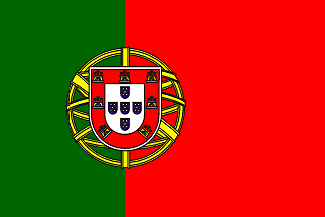

Thursday 31 May 2001
We drive from Leiria to Marvão. The route leads
us across Portugal to the East. Marvão is in the Alentejo province near
the Spanish Border. It is a mountain top village, with white washed cottages,
completely walled with a castle ruin. In Marvão we stay in the pousada.
The Poussada was converted from a number of adjacent cottages which are linked
together. The view both the restaurant, the outside terrace and our room is
stunning and streches well beyond the Spanish border.
.
After lunch we visit neighbouring Castelo de Vide. Before we get there we have
to come to the aide of two American ladies who have managed to get completely
stuck with their car in the narrow streets of the village. In
Castelo
de Vide is it still very hot (± 36°C). Fortunately the narrow streets
offer some shelter against the sun. We walk through the Juderia, the former
Jewish Quarter. Here we also find the former synagogue. Jews in Portugal,
opposed to those in Spain, for a long time enjoyed a relatively protected
position after the liberation of Portugal from the Moors. They had freedom of
religion and played a prominent role in the country's economy. Under increasing
pressure from Spain King Manuel I ordered the expulsion in 1496. Many moved to
the Netherlands. In the streets we see many elderly ladies making lace,
aparently a tradition here. The castle ruin overlooks the Juderia and the area
around the town. The view from the castle including Marvão in the distance is
beautiful.
We drive back to Marvão and have a cool white Port wine on the outdoor
patio,
before
we move on to the restaurant for a delicious dinner. Unfortunately the air
conditioning has broken down and we are in for a very warm night.
Friday 1 June 2001
After breakfast we wander around Marvão. Just like Castelo de Vide it is a white washed town with a castle ruin overlooking it. It soon becomes quite warm again. We get going on our way to Évora. The route is largely by motorways . In Évora it is hot too. We have some trouble getting to the hotel (Albergaria Solar Monfalim), despite the failry detailed map in our guide book (Rough Guide). Differences in street levels and one way streets, however are not indicated, and Evora turns out to have a lot of those. I walk to the hotel instead and get detailed instruction about how to reach the place by car.
In
the afternoon we have a look at theCapelo dos Ossos in the Igreja de São
Francisco. This is a very special and rather morbid sight. In the 15th and 16th
centuries Evara had about 42 monastic cemeteries, which took up rather a lot of
much-needed space. The Franciscans had a very practical solution to this
problem. They moved al the remains to this chapel and simply sorted the various
bone types and piled them up along the walls. The chapel holds the bones of more
than 5000 monks. The inscription "Nos ossos que aqui estamos pelos vossos
esperamos" (We bones are waiting for yours), does not leave much to
imagination.
At night we eat at a pizzeria and after that have a drink outside on the square Praça do Giraldo.
Saturday 2 June 2001
We get early to beat the heat and do some sightseeing. It seems to work. At
eight we on the street walking toward the Roman temple (2nd century), according
to popular wisdom devoted to the Diana. Apollo is a more probable bet. It is
supposed to be one of the best conserved temples of Portugal. Close to this area
is the cathedral. A robus romanesque building with gothic additions. The
interior is completely baroque and dates back to the 18th century. We take a
look in the high choir and a little museum belonging to the church. Around 11am
we are at the university.
It has a magnificent courtyard with a gallery around it. In the 18th century the
university
was close by the Marquis de Pombal, the then prime minister, who disliked
the Jesuits, who run the university back then. In the 1970s of the 20th century
the university was reopened.
Around 11 it gets pretty warm. We decide to take the car for a drive outside Evora. We drive first to Montemar, a small town with a castle. From there we drive on to Araiolos. There is a pousada here (Nossa Senhora da Assunção), in a former monastery. The chapel is still is use for weddings. Handy, when the married couple and their guest can easily move on from church to the wedding banquet. As it is saturday ( a popular day for weddings in Portugal) we can see this at first hand. The pousada has been fully renovated. It has been restored to it former glory, but with modern fittings and furniture, all in good harmony. We have lunch here. After lunch we stop in the village itself, which is known for its carpet industry. The village is quite deserted, but there is a carpet fair going on. The carpets are very traditional and boring to our tastes. We drive back to Evora, where spend the rest of the afternoon at the municipal pool among the local youth.
At night we eat (yet again) in a pousada, now it Evora itself (Loios)f. This one too is a former monastery. The restaurant is in the cloister. The service, alas, is somewhat sullen.